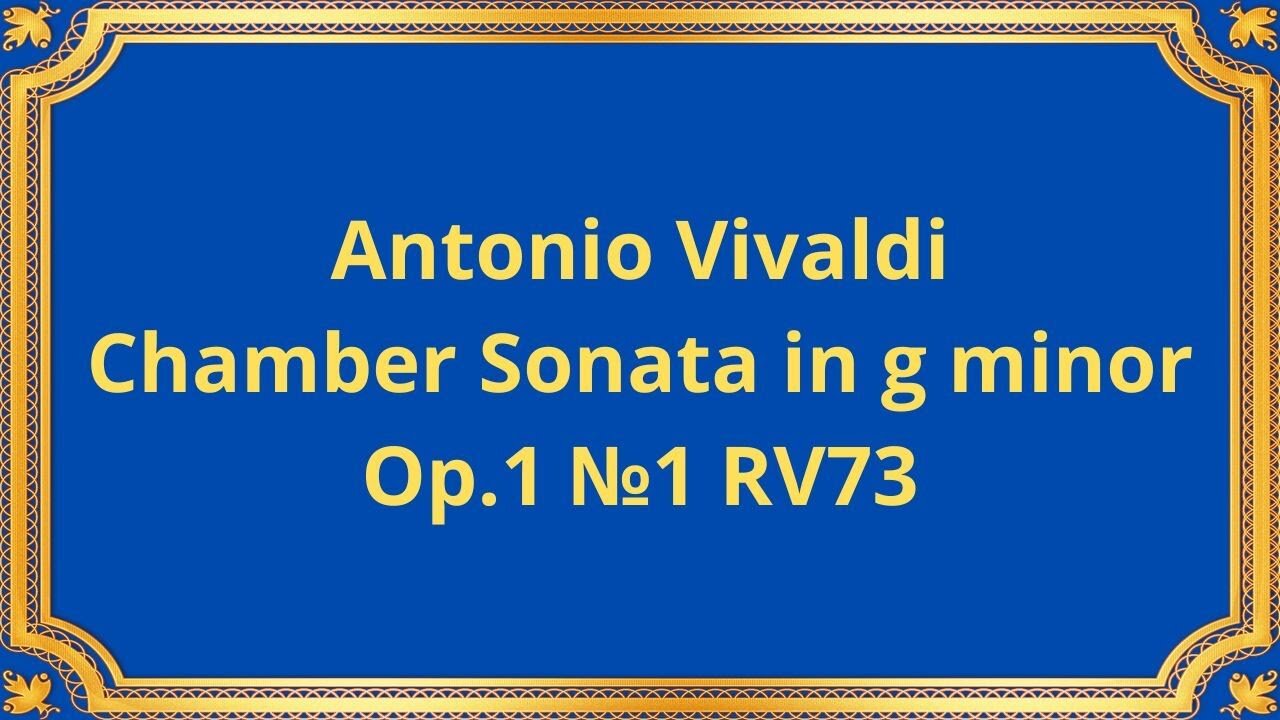Premium Only Content

Antonio Vivaldi Chamber Sonata in g minor Op.1 №1 RV73
#classicalmusic #AntonioVivaldi #ChamberSonata #gminor #Op1No1 #RV73 #musiccomposition #baroquemusic #classicalcomposers #musician #instrumental #sonata #musicperformance #musicappreciation #musictheory
Publication date 1935
Edgar Ortambert & Georges Drouet - violins
Louis Ruyssen - viola da gamba
Alban - harpsichord
Antonio Vivaldi, an influential Baroque composer, has left an indelible mark on the world of classical music. One of his captivating compositions is the Chamber Sonata in G minor, Op. 1 No. 1 RV73.
The Chamber Sonata in G minor, Op. 1 No. 1 RV73 was composed by Antonio Vivaldi in the early 18th century. Vivaldi, an Italian composer and violinist, was renowned for his innovative approach to composition and his contributions to the Baroque style. This particular sonata is part of Vivaldi's Opus 1, a collection of twelve sonatas published in 1705.
The Chamber Sonata in G minor follows the traditional sonata da chiesa (church sonata) structure, consisting of four movements: Adagio, Allegro, Largo, and Allegro. The opening Adagio establishes a solemn and introspective atmosphere, with its slow tempo and expressive melodies. The subsequent Allegro movement introduces a lively and energetic theme, showcasing Vivaldi's mastery of counterpoint and thematic development. The Largo movement provides a moment of respite, featuring a beautiful, lyrical melody that evokes a sense of tranquility. Finally, the concluding Allegro brings the sonata to a vibrant and exhilarating close, with its rapid tempo and intricate interplay between the instruments.
The Chamber Sonata in G minor showcases Vivaldi's ability to evoke a wide range of emotions through his music. The Adagio movement, with its poignant melodies and rich harmonies, conveys a sense of longing and introspection. The Allegro movements, on the other hand, exude energy and enthusiasm, inviting listeners to experience the joy and exuberance inherent in Vivaldi's compositions. The Largo movement provides a serene and contemplative interlude, allowing listeners to reflect and find solace in the beauty of the music. The dynamic interplay between the instruments throughout the sonata further enhances its emotional impact, creating a captivating musical narrative.
Antonio Vivaldi's Chamber Sonata in G minor, Op. 1 No. 1 RV73 has had a lasting impact on the world of classical music. Its innovative composition techniques, expressive melodies, and emotional depth have inspired countless musicians and composers throughout the centuries. Vivaldi's exploration of form and his ability to evoke a wide range of emotions continue to captivate audiences, making this sonata a beloved and frequently performed piece in the classical repertoire.
Conclusion:
Antonio Vivaldi's Chamber Sonata in G minor, Op. 1 No. 1 RV73 stands as a testament to the composer's genius and his contributions to the Baroque era. Through its historical significance, structural elements, and emotive qualities, this musical work continues to enchant audiences and serve as a testament to the enduring power of classical music. As we immerse ourselves in the intricate melodies and evocative harmonies of this composition, we gain a deeper appreciation for Vivaldi's artistry and the timeless beauty of his music.
You have the opportunity to support the channel:
https://destream.net/live/RadSiarAl/donate
https://www.buymeacoffee.com/6355radsiaral
-
 6:07
6:07
Classical music_Music Inspiration
1 month agoJoseph Haydn Piano Sonata in D Major, Hob. XVI:51
821 -
 LIVE
LIVE
Conspiracy Pilled
12 hours agoAvowed
86 watching -
 5:31
5:31
Adam Does Movies
23 hours ago $3.00 earnedThe Monkey Movie Review - This Is From The Longlegs Director?
32.9K3 -
 14:47
14:47
Tactical Considerations
15 hours ago $3.99 earnedClassic Precision Woox Furiosa Bergara Premier 6.5 CREED
36.4K1 -
 40:44
40:44
Rethinking the Dollar
1 day agoDonald & Elon Head to Fort Knox—What Are They Planning?
25.6K22 -
 1:10:15
1:10:15
MTNTOUGH Fitness Lab
1 day ago"My Baseball Career Wasn't Enough": Adam LaRoche's Life-Changing Anti-Trafficking M
20.8K4 -
 1:00:12
1:00:12
The Tom Renz Show
20 hours agoComing to America & Coming to Christ
48.8K7 -
 1:12:21
1:12:21
TheRyanMcMillanShow
1 day ago $0.58 earnedDebbie Lee: Mother of First Navy Seal Killed In Iraq, Marc Lee - RMS 019
22.2K1 -
 38:05
38:05
Uncommon Sense In Current Times
17 hours ago $2.38 earnedIs Israel Being Forced Into a Bad Deal? David Rubin Exposes the Truth | Uncommon Sense
35K17 -

FreshandFit
12 hours agoAfter Hours w/ Girls
141K100